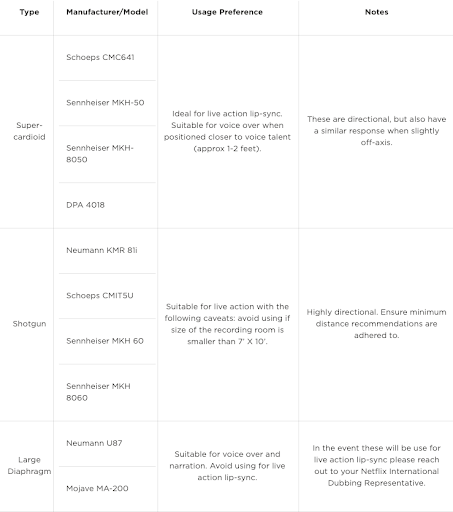Localized Dialogue Recording Recommendations (Live Action)
- The recording area should be well dampened from room reflections, hard surfaces, ventilation and resonating metallic vibrations from music stands and other supporting items.
- In the recordings, the booth space should not be audible. If the booth sounds like a booth, that is the first challenge to address.
- Minimize reflective surfaces using various materials
- Position absorption panels to isolate resonances
- Experiment recording in various locations within the booth
- The recording space should be approximately at least 7’ X 10’ to allow for proper mic-ing with minimal reflections and resonances.
- Avoid using dynamic compression, limiting or equalization (EQ) during recording. These processes are handled during mixing.
- Record with one mic as the primary source for principle dialogue.
- For live-action dialogue especially, be aware of the proximity of the main mic. Dubbing too close will create an upfront sound that will sit on top of the M&E, rather than blending in. There is no requirement to recreate the exact tonality of the original version, instead attempt to make the dialogue sound like a well-recorded, on-set recording.
- For Narrative Voice Over a large-diaphragm microphone can be used if needed.
- When recording the primary dialogue with a super-cardioid microphone placed on a boom, a distance of approximately two feet from the actor is recommended. If using a shotgun mic a distance of three feet is recommended.
- Point the microphone directly at the voice talent, on-axis.
- Note: Some use the terms “boom mic” and “shotgun” interchangeably however it is common to see super-cardioids attached to a boom.
- When using a boom, use a high-quality shock mount to avoid vibrations.
- Avoid using a windscreen during recording unless absolutely necessary.
- When recording voice-over (where the original recording has a narrative, non-dialogue, storytelling quality) a large-diaphragm mic is recommended. In scenarios where the aim is to maintain the same tonality as principal dialogue, a super-cardioid microphone can be utilized.
- In situations where there is a need to match existing dialogue that will remain in the final mix. Pre-existing dialogue may be easier to match using a Lavalier if the OV audio was recorded that way.
- If all dialogue is being replaced with a new language (like most shows), a lavalier recording is generally not needed.
- Lavalier recordings tend to be muffled and require a lot of processing to achieve a good dialogue sound. (the sound when two actors hug in a scene is a good example of that muffled sound)
- Lavalier recordings are prone to clothing rubbing sounds and off-axis changes in the dialogue.
- Ensure you are using a high-quality preamp. The following is a non-exclusive list of suggestions. Netflix will continue to update these lists and welcomes any recommendations or feedback. Please reach out to your Netflix International Dubbing representative:
- API
- Avalon
- BAE
- Daking
- Focusrite ISA range
- Grace Design
- Great River
- John Hardy
- Millenia
- Neve
- Sound Devices
- Use the same preamps and mics on characters conversing in the same scene. Differences can manifest in unacceptable variations between recordings that may result in Netflix rejecting the content.
- In the event that a character is to be recorded in multiple studios, special care to match microphones, preamps, mic placement, and overall tonality should be observed. Additionally, if just one character is recorded entirely in a different studio than the other characters in the production, special care should be taken to match the recording chain as closely as possible. Differences in the tonality of recordings can manifest in unacceptable variations between recordings that may result in Netflix rejecting the content.
Microphone List
Below is a non-exclusive list of microphones with guidance around the type(s) of recordings they should be used for. Netflix will continue to update this list. Please reach out to your Netflix International Dubbing representative if you have any recommendations.
Please Note: Netflix reserves the right to request the use of specific microphones to be utilized on recordings made by our partners. Any such request will be communicated at the beginning phase of a project (upon project kickoff email). The list is subject to possible changes.
